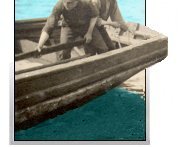 |
 |

|
Jersey Harbour Jersey Harbour (pop. 1966, 169) was a resettled community in Fortune Bay about 3 km northeast of Harbour Breton.The firm of Nicolle and Co. from Jersey set up at Jersey Harbour some time between 1789 and 1803 and became one of the first major mercantile operations in Fortune Bay. The company immediately recruited servants in Jersey and later in Dorset, 40 arriving from Jersey in 1803. In that year there were 95 men fishing from the settlement. The company's small schooners collected fish all along the south coast for export to Europe. In 1863 Nicolle began operating under the name Nicolle de Quitteville and Co. and continued to operate from Jersey Harbour until 1872, when it was bought out by DeGrouchy, Renouf, Clement and Co. When that company declared insolvency in 1886, the Jersey connection was broken. Other merchants operating there around this time were F.P. Jean and J. Mauger. When Newfoundland's first official census was taken in 1836, Jersey Harbour had a population of 108. In 1869 the population was 155. By the mid-1870s, the Fortune Bay fishery began to decline from overfishing of herring. When more and more fishermen turned to the bank fishery, the population of Jersey Harbour declined by 1884 to 123. The inshore fishery rebounded during the first decades of the 1900s and by 1921 the population had peaked at 210, the level around which it remained until the government's resettlement program of the 1960s. Three firms, owned by Chesley Boyce, D. Boyce and Joseph Rose, were operating from Jersey Harbour in the 1930s. Most early settlers were members of the Church of England, but there were 16 Roman Catholics in 1836. Children were attending school by 1848, when teachers were provided for six months at Jersey Harbour and six at Brunette. By the 1930s there were two Church of England schools - the North Side School and St. Anne's. Despite the introduction of a coastal steamship service in Fortune Bay as early as the 1870s, the community was relatively isolated. Consequently by 1969 everyone had relocated. Thirty-four families moved to Harbour Breton, while the remainder went to such centres as Grand Bank, Port aux Basques, English Harbour West, Marystown and St. John's. From the Encyclopedia of Newfoundland and Labrador
|
|||||||||||||||||
© 2003 - 2012 Maritime History Archive, Memorial University |